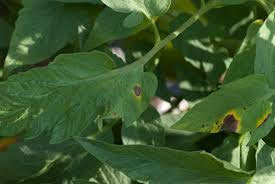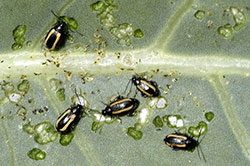Cleaning up vegetable garden in fall following a hard freeze can pay off next year. If gardeners have had problems with the following diseases or insects, do encourage follow-through with a thorough vegetable garden cleanup this fall, soon after harvest is complete. A thorough cleanup consists of complete removal of all infested plants including weeds in large plastic garden clean-up bags.
- Early blight – The fungus over winters on diseased plants and perennial weeds such as horse nettle and nightshades. Remove diseased tomato plant debris and clear weeds. Spores are spread to new garden plants by splashing water, wind and insects. Consider moving tomatoes to a new location next year if possible.
- Viruses – The most noticeable symptom of TSWV and INSV (Tomato spotted wilt and Impatiens necrotic spot) on tomatoes are yellow rings or spots on fruit. They also affect lettuce and pepper, as well as many weed species, such as bindweed and nightshade. Viruses survive on plants, not in the soil. They are carried to vegetables by Western flower thrips that fed on infected plants. Clean up affected perennial weeds.
- Thrips – Onion thrips affect onion, cabbage and beans and are often the most common type of thrips on vegetables and flowers. Because thrips pupae over
 winter in the crevices of plants or soil, cleaning up infested weeds as well as vegetables in the fall is very important. Western flower thrips are native to warmer areas of the Mountain West and have many weed and crop hosts. They over -winter in a similar fashion as onion thrips.
winter in the crevices of plants or soil, cleaning up infested weeds as well as vegetables in the fall is very important. Western flower thrips are native to warmer areas of the Mountain West and have many weed and crop hosts. They over -winter in a similar fashion as onion thrips. - Flea beetles – flea beetles spend the winter as adults hiding under leaves, dirt clods or in other protected sites. Fall cleanup of plants may eliminate some but not all hiding places. Use additional means such as trap crops during the growing season for control.
For more information, see the following Colorado State Extension fact sheet(s).



